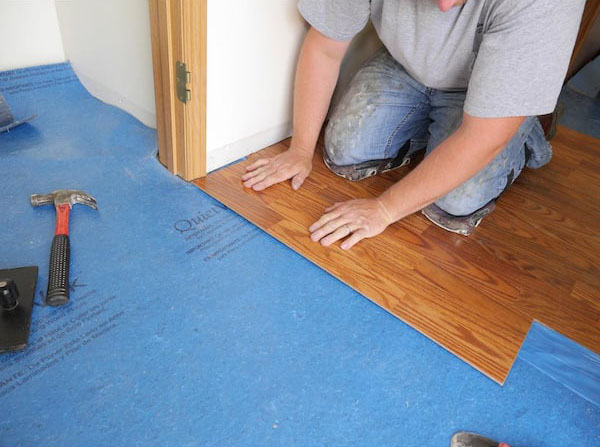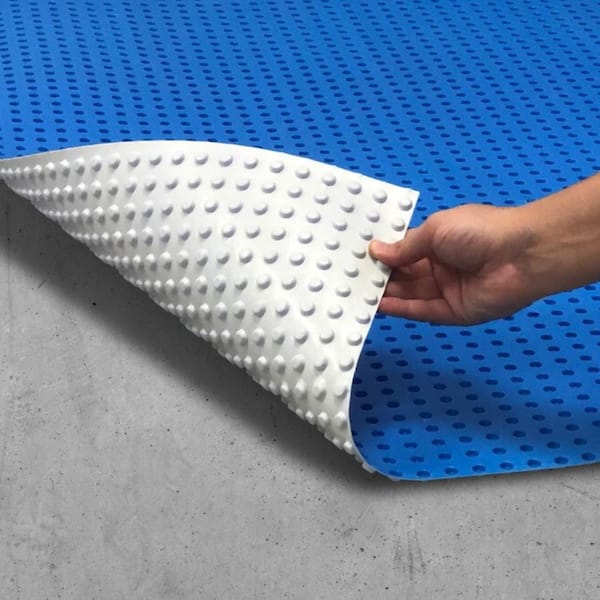How to Choose Floor Underlayment
Sound Proofing, Cushioning, and Moisture Barriers. Learn the different types of floor underlayment, which one is best for your floor, installation, and recommendations.
Recently I was working with a customer who was very concerned about choosing the right underlayment. She lived in a second story condo, and it required HOA approval. I assured her that our underlayment acts as a moisture barrier, cushions the floor, and has sound proofing to meet most acoustical standards for the HOA. But that wasn’t enough. She persisted and wanted to know all the details of thickness, rating, type of materials, etc.
At that point I realized my choice of underlayment has been rather standard. With so many types of flooring, and higher consumer (and HOA) standards folks have a lot of questions about floor underlayment.
So, with this article we discuss the different types of floor underlayment, and answer all your questions. We’ll also make recommendations that will work in *almost* any environment, which types are best for your specific floor, and how much it will cost you.
What Is Underlayment
If you’re new to the flooring world, you may not even have any idea what underlayment is. Someone probably told you that you needed it, and you went to look it up only to end up totally confused.
Simply put, underlayment is a layer of material between your subfloor and your floor. While some flooring comes with the underlayment attached, others will require you to install a separate underlayment. Most of the time, underlayment consists of rubber, cork, foam, or felt. Each option has different qualities to suit the needs of various floors and rooms. Though your underlayment will be invisible beneath your floor, choosing the right type will improve your flooring and help it to last longer.
Acoustical floor underlays are designed to help reduce impact noise and are critical in the construction of apartments, offices, and any multi-story building with a lot of foot traffic.
Why Do I Need Underlayment?
While underlayment isn’t always necessary, there are always benefits to it. One of the most significant reasons to install underlayment is the added stability and durability. Underlayment provides support for your floor, helps smooth subfloor imperfections, and acts as a moisture barrier.
- Provides support for your flooring – Adding underlayment provides more stability.
- Moisture barrier – For areas prone to moisture build up under the floor, this is a big feature that helps to protect your flooring.
- Helps smooth subfloor imperfections – Underlayment ensures your floor lays correctly over your subfloors.
- Reduces Airborne Noise– Underlayment muffles sounds caused by footsteps.
- Reduces Impact Sounds– Underlayment provides an extra sound barrier between levels of homes.
- Adds softness to your flooring – All types of flooring can benefit from underlayment that adds cushion when you walk.
- Increases the longevity of your floor – By supporting your floor and protecting it against friction, underlayment will help keep your floors beautiful for years to come.
Types of Floor Underlayment
Materials used for floor underlayment varies quite a bit. The priority is usually having a moisture barrier, which would typically mean plastic or foam. The next priority might be to add stability in case the floor shifts, making a plywood underlayment important. But, very common today are homeowners installing a vinyl floor that needs an acoustical barrier underlayment to reduce noise.
Below are the different kinds of floor underlayment available.
Foam Underlayment
Foam is one of the most popular types of underlayment because it’s affordable, easily installed, and can be used for just about any type of flooring. It is typically manufactured from polyethylene or polypropylene foam, and it comes in rolls or sheets.
If you’re looking for an “all-in-one” solution this is for you – absorbing sound, reducing impact noise, improving acoustics, and softens your footsteps on the floor. Most brands also act as a moisture barrier, preventing water vapor from reaching the flooring.
Foam underlayment is typically used in laminate and engineered hardwood floors, however many can be used for hardwoods, especially if you’re installed between the subfloor and a plywood underlayment.
- Sound Insulation
- Moisture Resistance
- Comfort / Padding
Recommended Foam Underlayment:
FloorMuffler is top rated, durable, works with almost any flooring, and easy to install. If you’re looking for a moisture barrier for under your hardwood floors this is one of the best at this price.
Available at most warehouse stores, Roberts is known for its quality and easy installation. This is typically used for laminate and engineered floors but can be laid under the plywood for a floating hardwood floor. We chose this for its cushioning. Our usage showed that it’s superior at softening your hard flooring and muffle sounds.
DMX 1-STEP – 100 SQ. FT. UNDERLAYMENT FOR VINYL PLANKS, LAMINATE AND ENGINEERED HARDWOOD FLOORS
Thicker than most underlayment, this is a top quality product that acts as a moisture barrier, padding, and sound barrier. DMX 1-STEP 2.0 is designed specifically for use in basements and/or areas where moisture is a problem. Thicker than most this product has a higher rating for acoustics, and making a softer feel under foot.
Acoustic Flooring Underlay
Firstly Acoustic Flooring Underlay can be called many things in different parts of the world including:
- Acoustic or Acoustical Underlayment
- Acoustic foam
- Sound Mat
- Impact Mat
- Resilient Underlay
- Rubber Mat
- Soundproof Mat
- Sound Control Underlayment
The sole function of the acoustic flooring underlayment is to reduce the amount of impact noise travelling through a floor from objects dropping, footsteps and furniture movement on hard surface floor finishes in any type of building.
Acoustic Underlay is predominantly used in multi-resident dwellings such as:
- Hotel or Serviced Apartments
- Condominiums
- Apartments
In some countries it is a legal requirement to design and install a floor/ceiling assembly that will bring the noise levels down by a specific amount. The building management of some condo/apartments can also stipulate that if you are changing the flooring in your unit from what was originally installed then you must install an acoustic flooring underlay to make sure the impact noise performance is maintained.
Acoustic underlayments are very dense materials designed to deaden sound vibrations. One quick way to determine density is to look at a material’s weight in relation to its size.
Typically folks will just choose a thick foam underlayment that has been acoustically tested, and rated, to show how much impact noise it reduces. Some underlayments, however, are designed specifically for acoustics and not necessarily great at softening the floor or as a moisture barrier.
Lots of technical details about acoustical underlayment, but here are a couple that are highly-rated for acoustics and are easy to install. But keep in mind, even if it’s not a requirement of your new floor construction it’s always a good thing to install underlayment that reduces airborne noise. Otherwise, you’ll have an echo in the room when you walk!
Felt Underlayment
Felt underlayment is usually made from recycled fibers and is often denser than foam. The density is what makes felt a great sound absorber. Not only is felt great at absorbing sound, it’s also great at insulating your home and cushioning your step -some say better than other underlayments! Since felt fibers are made from recycled materials, it’s also an environmentally friendly underlayment choice.
It’s often thought of as the best underlayment for hardwood floors. However, when hardwood floor installations require a moisture barrier it requires an additional layer or a felt underlayment that has the moisture barrier built in.
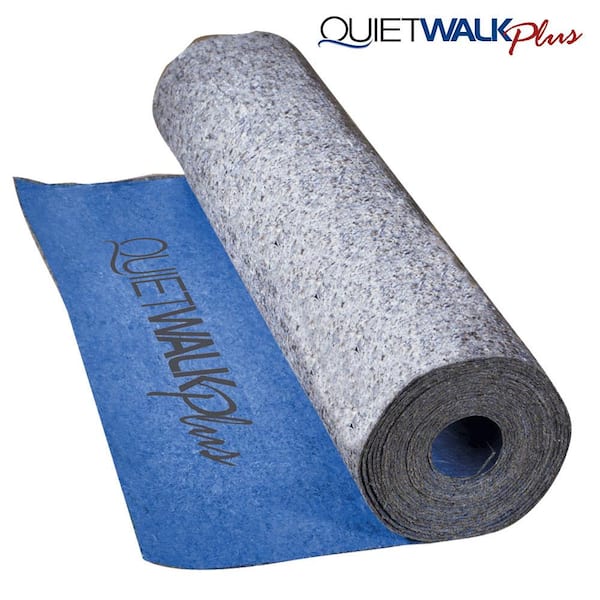
QuietWalk Max 100sft – Premium underlayment, but higher rating for acoustics. Quietwalk max’s unique silver film provides thermal reflectivity to help keep your home comfortable; it also acts as a barrier against moisture and high ph levels which may occur in concrete subfloors.
Rubber Floor Underlayment
With all the choices out there, why use rubber as underlayment? You can just go to your nearby warehouse store and pick up some rolls of foam – so why bother? Well, it turns out rubber is (probably) the best underlayment you can use.
Rubber is one of the best choices for underlayment because it is super versatile. It can be used for almost any type of floor, easy to install, extremely durable, and is multi-purpose.
Rubber underlayment can be purchased thin or very thick for super sound-proofing. Rubber floor underlayment is the must-have for anyone looking to soundproof their space. It creates dampening and absorption to reduce both impact and airborne noise. Thicker underlayment offers better soundproofing, different types of flooring require specific underlayment, and cheaper options may not offer the same durability and soundproofing capabilities as higher-priced options.
Available in thickness from 3mm, 5mm, 6mm, 10mm and 12mm thicknesses. 12mm would be for extreme soundproofing and cushioning.
Rubber underlayment is most commonly used under wood, tile or carpet, but cannot be used under vinyl due to staining. Rubber is an excellent choice over wood and concrete subfloors and is super easy to install underneath just about any floor. Since it’s often made from recycled rubber products, it’s eco-friendly, too.
Features and Benefits:
- Significantly reduces both airborne sounds and structural vibrations including voices, television, music, and footsteps
- Makes click-together floating floors sound solid underfoot
- Offers moisture barrier protection
- Designed to be installed directly under finished floors
- Eliminates and reduces subfloor imperfections
- Easy and fast to install
- Mold and mildew resistant
One other way it’s unique is that rubber underlayment lays flat and doesn’t curl up. This is a common complaint with other types of underlayment.
Recommendations:
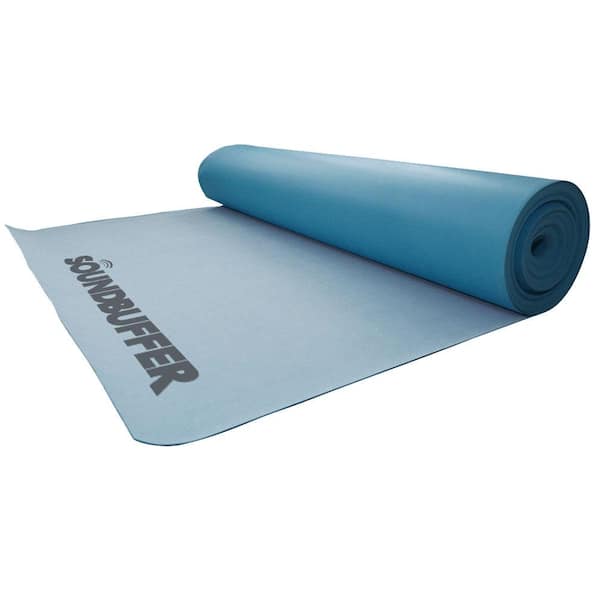
Made from 100% virgin latex rubber, SoundBuffer is CRI (Carpet and Rug Institute) certified and residential and commercial rated for under a variety of overlying flooring products.
- Provides excellent acoustical performance
- Minimizes impressions and indentations than traditional foams
- CRI certified and residential and commercial rated
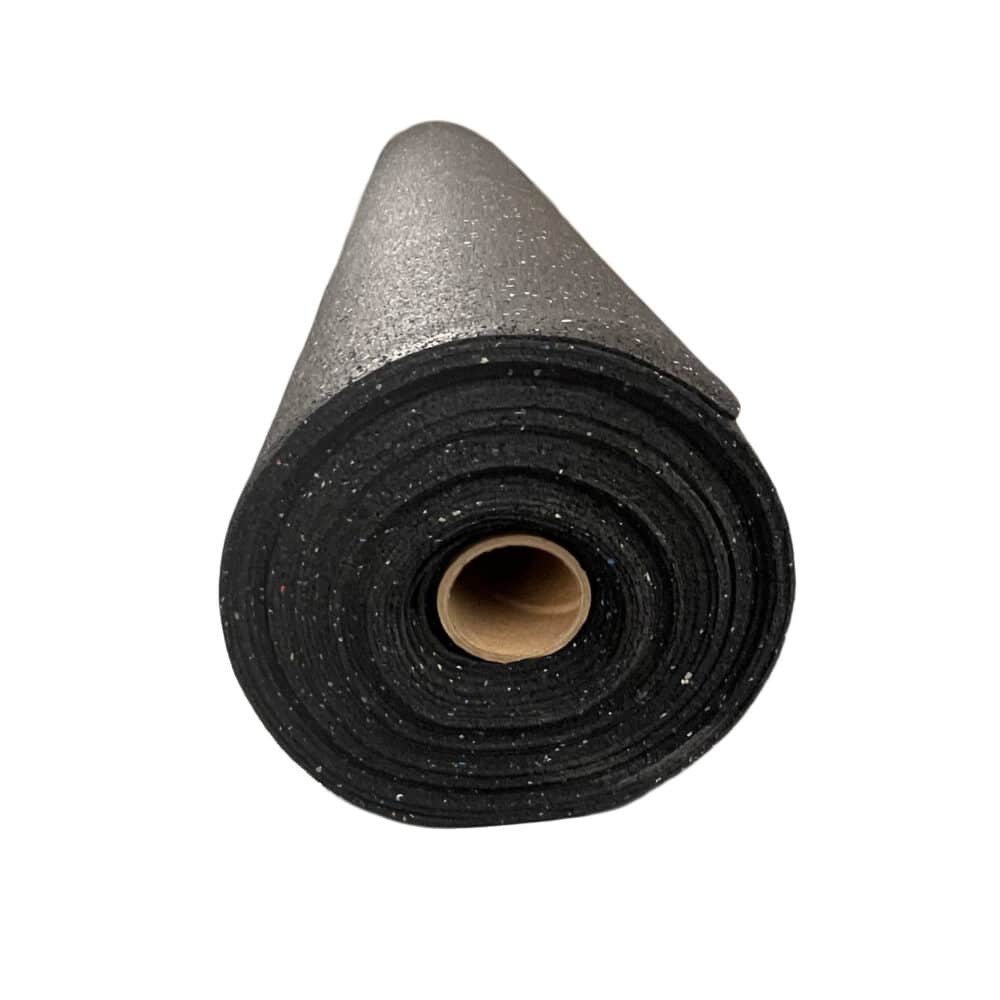
AbsorbaSound – 5 mm Acoustical Rubber Underlayment for Hard Surface Floors 100 sqft. Roll
- QuietSound Rolled Underlayment is the premium solution to the problem of noise transmission between upper floors
- Recycled rubber underlayment is impervious to the elements
- Recycled rubber remains permanently resilient and will not become brittle with exposure to air
Cork Underlayment
Like rubber, it doesn’t seem to make sense at first why someone would use cork for underlayment. It’s very old school but definitely has its advantages.
Cork underlayment offers increased temperature control as well as acoustic properties that are well documented. Cork underlay offers a simple “floor lift” for those projects where the owner is attempting to match the height of flooring in another room.
Cork underlayment tends to be a favorite among apartment and condo owners, because of its superior sound absorption. Cork underlayment can also make on grade and below grade floors feel much warmer with their thermal insulating qualities.
Cork is also an eco-friendly choice in underlayment. Plus, the natural antimicrobial nature of cork prevents the growth of bacteria, mold, and mildew as well. That makes cork a great choice for allergy sufferers.
On the downside, although you can install it underneath just about any floor, it is not the best choice for all environments. Water can damage cork flooring, so for basements, bathrooms and other flood-prone areas, you might want to go with polyethylene or rubber instead.
Recommendations:
Dream Home – 12 mm Cork Underlayment 2 ft. x 3 ft. Sheet 150 sqft.
Features & Benefits:
- Reduces sound transmission from both the surface of a floor as well as through the floor to living spaces below
- Use under ceramic tile, stone, marble, glued wood flooring and floating floors
- Acts as a crack isolation membrane that resists transfer of stress cracks
- Reduces thermal transmission, increasing the effectiveness of floor heating
- Easy to install in both glue-down and looselay configurations
For LEED & Other Green Building Programs:
Natural cork products meet many of the key criteria of the organizations that promote and support green building initiatives.
Acoustical Performance
- IIC 71
- STC 62
- Delta IIC 24
QEP – 200 sq. ft. 48 in. x 50 ft. x 1/4 in. Natural Cork Underlayment Roll
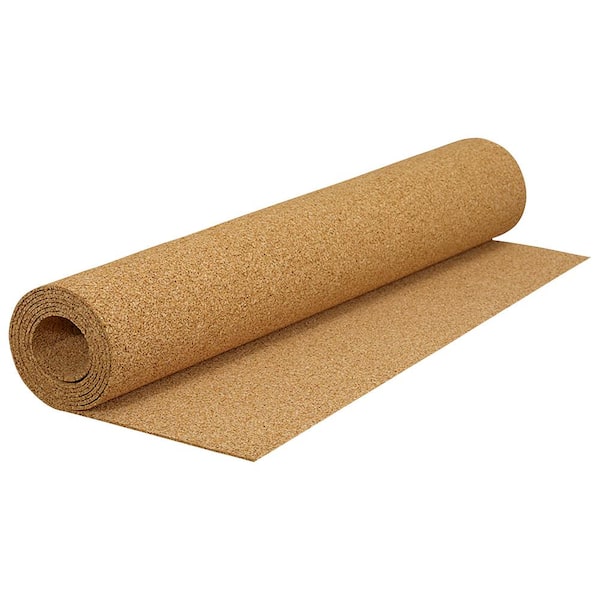
Improve the air quality in your home with QEP’s Natural Cork Underlayment. This environmentally-friendly cork underlayment is naturally hypoallergenic and contributes to a healthier indoor air quality.
- For use with ceramic and porcelain tile, stone, marble, engineered hardwood and laminate floors
- Crack isolation membrane that resists the transfer of stress cracks from subfloor through to flooring surfaces
- Acoustical sound control under ceramic tile and stone for less sound transfer throughout the room
Plywood Underlayment
Plywood underlayment is most commonly used under resilient flooring materials, such as vinyl and linoleum sheets and tiles. It can also be often used under hardwood flooring when doing a floating floor. It creates a uniform, smooth surface and creates separation from the subflooring – creating what is known as a floating floor.
Floating floors are often used when the subfloor is concrete, or has a tendency to shift. The separation it creates not only makes the floor feel smoother, but ads cushion, insulation, and adds to the acoustic barrier.
A plywood underlayment, or floating floor, is also highly recommended for hardwood flooring to reduce “creaking”. Over time if the subfloor will shift and the hardwood flooring will expand or contract slightly, causing it to creak as you walk on it. Plywood creates the separation so that the floor and subfloor can move independently to reduce creaks.
Plywood Underlayment Is Not Subflooring
Often, the terms “subfloor” and “underlayment” are used interchangeably. I’ve sometimes made this mistake myself. But, although the flooring rests, or is attached, to the plywood underlayment it’s still not a subfloor.
Recommended Plywood Underlayment
CDX plywood is our recommended type of plywood underlayment; however OSB is often the preferred type.
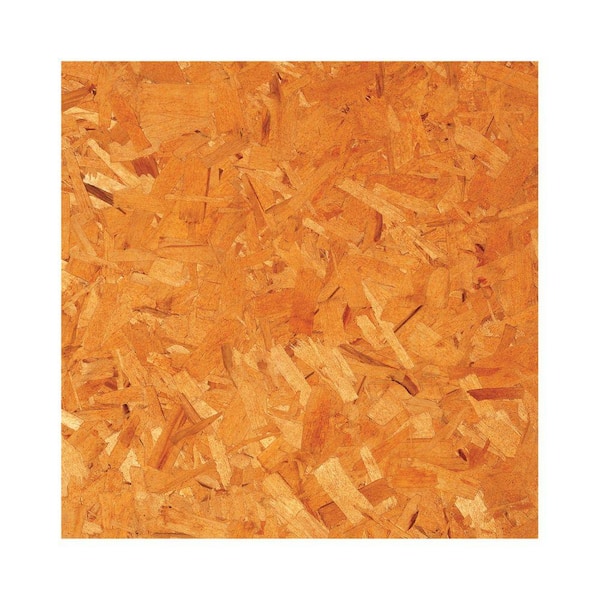
OSB
OSB is often referred to as “OSB plywood”, but this is misleading because OSB and plywood are two entirely different types of construction materials.
“OSB” stands for Oriented Strand Board. Unlike plywood, it’s made by combining wood strands or flakes with adhesive. Then they’re bonded together under heat and pressure.
While OSB and plywood have similar uses, they differ in terms of weight, consistency, and cost.
OSB is generally less expensive than plywood and has become more prevalent in construction for flooring because of its uniformity and low cost. OSB is easier to use than plywood because you don’t have to worry about the direction of the wood grain. It’s also cheaper. However, OSB is less resistant to moisture than CDX plywood which is a big issue.
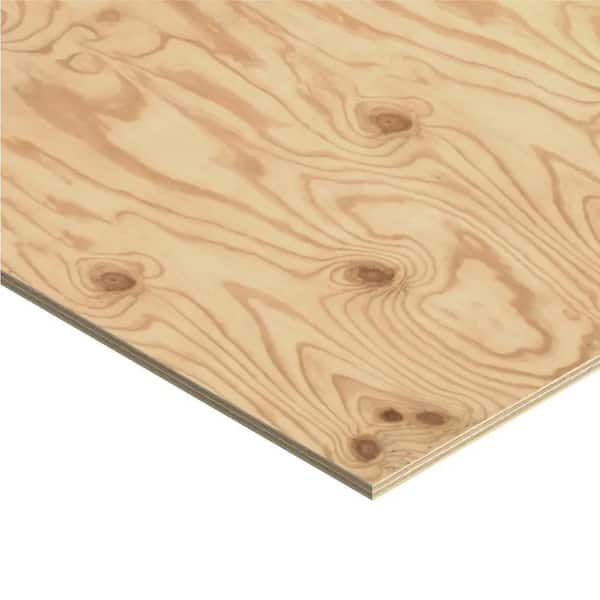
CDX Plywood
The “X” in CDX plywood refers to the type of glue used in the plywood. CDX can handle exposure to moisture better than most, but it is not waterproof. With the adhesive used, CDX is moisture resistant. However, if exposed to moisture over a long period of time it can deteriorate. Plywood holds nails and screws better and doesn’t deteriorate as quickly when it gets wet compared to OSB.
Moisture Barrier for Plywood Underlayment
Although OSB, and CDX, are somewhat moisture resistant, they are not waterproof. Prolonged exposure to moisture will deteriorate ANY plywood. Therefore, it’s recommended to use a moisture barrier under any plywood underlayment. It can be a simple sheet of thick plastic, but best to go a step further. Typically the best is a low-cost foam (polyethylene) underlayment which will act as a moisture barrier, while also add cushioning, and help with acoustics – reducing foot echoes.
Recommended Moisture Barrier/Underlayment for Plywood
Underlayment For Each Flooring Type
Best Tile Underlayment
- CBU or Cement Board
- Ditra Uncoupling Membrane – Schluter DITRA and DITRA-XL
- Self-leveling Underlayment
Best Laminate Underlayment
- Foam Laminate Underlayment
- Acoustical underlayment for laminate
Best Hardwood Underlayment
- Plywood
- Felt
- Cork
- Rubber
- Foam
Best Carpet Underlayment
- Foam – Use the best quality you can afford for better wear
Best Vinyl Underlayment
- CDX Plywood or OSB
Conclusion
Hopefully this helped with the choices you’ll be making with underlayment. It’s best to not skip this step, regardless of your flooring, since it will not only protect your floors from moisture, noise, and create cushioning. But also help protect your flooring in the long run.


